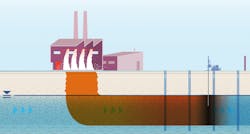Brownfield Construction and Water Contamination
Above, an abandoned foundry.
By Ryan Moore and Ryan Miller
New construction at vacant, former industrial properties, referred to as brownfields, has increased dramatically over the past decade. Even before the COVID-19 pandemic, the growth of e-commerce was driving a revolution in the new construction of industrial warehouses and last-mile distribution centers, which has only accelerated since early 2020. According to one source, the United States will need one billion square feet of industrial warehouse space over the next five years to keep up with e-commerce demand.1 Mixed-use residential/commercial redevelopment of brownfields also continues steadily in many areas across the U.S.
Due to the continued need for affordable land in areas accessible to highly populated areas, and fueled by tax incentives, many of these future buildings will be constructed on or near brownfields where chemical releases have occurred. Chemical vapors form when chemical substances containing chlorinated solvents, petroleum hydrocarbons, or other volatile compounds, commonly used in industry, are spilled or improperly disposed. Over time, these chemicals often migrate through the soil, contaminated groundwater, and form chemical vapor plumes.
Building occupants might be at risk of exposure to indoor air containing these vapors if a building is constructed within a contaminant vapor plume footprint. Inhalation of chemical vapors is often hazardous to human health, even at indoor air concentrations not detected by smell (i.e., below the odor threshold).
Additionally, in just the last five years, there has been an increased awareness relating to a class of chemicals known as per- and polyfluoroalkyl substances (PFAS) and their widespread impact on public and private drinking water supplies. According to the Environmental Working Group, over 200 million people may be drinking water tainted with these ''forever'' chemicals that do not degrade, resulting in PFAS accumulations in nearly all Americans' bloodstreams.2 For these reasons, some species of PFAS are on track to be designated as hazardous substances by the Environmental Protection Agency. Many states have regulations on the books or in development, treating several PFAS compounds as such.
Some of the highest PFAS exposure threats that could require active mitigation in the future may be found at or downstream of former or current military bases, airports, landfills, petrochemical facilities, pulp and paper mills, metal plating facilities, textile and plastics manufacturers, to name a few. At many of these facilities, PFAS impacted areas are often associated with shallow groundwater near discharge source locations or sewer collection basins where fire training or testing was conducted using aqueous film-forming foams (AFFF) that contain PFAS.
Once in groundwater, it is up to chance whether PFAS contaminants pose an environmental or human health risk, depending on factors such as the species and concentration of PFAS, the speed of groundwater movement, and the distance to the drinking water well or other receptors.
[Editor's Note: The recently passed Infrastructure Bill includes a $10 billion provision to clean up PFAS.]
Proactive Steps to Mitigate Environmental Liability Risk
Understand Your Site History
It starts with due diligence. It is vital that property owners and developers understand the property's history. This understanding generally involves a Phase I Environmental Site Assessment (ESA), which includes information gathering and interviews to understand what chemicals were stored, where they were stored, and how they were used. When it comes to PFAS, it is critical to know whether fire training or fire prevention systems tests ever occurred on the property and if manufacturing operations included use of potentially harmful chemicals.
Also, the current and potential future regulations that could impact the facility should be understood. Research guidelines regarding the groundwater use local to your facility and whether potential receptors (i.e., a potable well or a stream) are located near a facility. Retaining environmental legal counsel expert in PFAS matters is advised before undertaking any subsurface investigation activities to assess PFAS contamination or before a property transaction requiring an environmental site assessment (Phase 1 or Phase II ESA).
Safe, Economical, and Effective Means to Address Vapor Intrusion Risk
Years ago, vapor mitigation industry leaders assessed the trends and foresaw the need for contaminant vapor barriers to address the increased vapor intrusion risk resulting from construction on brownfields and other environmentally distressed properties. Advanced vapor intrusion mitigation systems incorporate the latest technological innovations to offer the highest chemical protection available. These advanced systems comprise patented, state-of-the-art materials, including metallized films and nitrile-advanced asphalt latex (developed by Land Science®) that offer up to one-hundred times more chemical protection than traditional vapor intrusion mitigation systems.
While offering the highest level of protection against vapor intrusion, these advanced systems are often easier and faster to install than older systems and are priced competitively. Brownfield property developers and building contractors are rapidly increasing the incorporation of these systems into their building plans to address any potential vapor intrusion risk, known or unknown, and to ensure the construction project stays on schedule and reduce any potential future liability. Additionally, comparative cost analyses have shown that it is often less expensive to pre-emptively mitigate vapor intrusion rather than investigate and mitigate after a problem is found.
If PFAS Impacts on Groundwater is Confirmed Act Quickly
If an investigation resulting from the due diligence activities described above has detected PFAS contamination in groundwater at concentrations requiring remediation, one approach has demonstrated long-term effectiveness and economy for removing PFAS, and other organic contaminants, from groundwater. This remedial approach involves an in situ PFAS treatment method using a colloidal form of activated carbon applied directly to or ahead of a contaminated zone in groundwater. In this process, aquifer materials are transformed into filtering media, cleaning the impacted groundwater as it migrates through the treatment zone. As the treatment is driven by the natural movement of groundwater and requires no mechanical pumping, it is also highly economical.
As brownfield redevelopment continues to increase, so will the occurrence of previously unknown environmental contamination. Understanding the potential environmental liability risks and the methods for mitigating these risks is the key to ensuring a safe environment for future building occupants and avoiding unnecessary and potentially very costly environmental exposure.
References
1. Latest Trends in the Industrial Real Estate Sector Here to Stay - Area Development. Accessed October 5, 2021. https://www.areadevelopment.com/manufacturing-industrial/Q2-2021/latest-trends-in-industrial-real-estate-sector.shtml
2. Andrews DQ, Naidenko OV. Population-Wide Exposure to Per- and Polyfluoroalkyl Substances from Drinking Water in the United States. Environ Sci Technol Lett. 2020;7(12):931-936. doi:10.1021/acs.estlett.0c00713
Ryan Moore - As the REGENESIS PFAS lead, Moore focuses on collaborating with environmental professionals and the industry in communicating effective, proven approaches to manage sites where PFAS contaminants exceed regulatory standards. He has more than 20 years of in situ remediation, environmental project management, and laboratory account executive experience relating to multimedia contamination sites throughout the U.S. He has presented at multiple conferences and environmental symposia on PFAS in situ remediation.
Ryan Miller - As the East Region Manager of the Land Science® division of REGENESIS, Inc., Miller’s role includes providing technical support in the design and installation of TerraShield, Nitra-Seal, MonoShield and Retro-Coat vapor mitigation systems, and educating the environmental community on the advancements in vapor intrusion barrier technology, implementation, and quality control. He has extensive experience in the environmental consulting industry, focusing his career on brownfield redevelopment projects and specializing in vapor intrusion mitigation.

